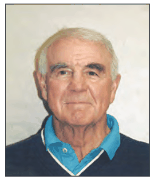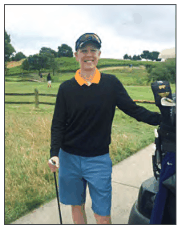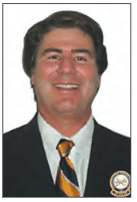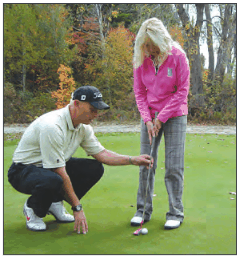Sally J. Sportsman USGTF Contributing Writer, Orlando, Florida
 USGTF member Dr. Gerald Walford, a retired college professor in sports sciences, as well as a hockey and golf coach, believes that a winning mindset entails the elimination of distractions in order to focus on what is essential. He is an ardent supporter of Zen, in which one learns what is needed – a golf movement, for example – until it becomes muscle memory; then it’s forgotten and becomes automatic.
USGTF member Dr. Gerald Walford, a retired college professor in sports sciences, as well as a hockey and golf coach, believes that a winning mindset entails the elimination of distractions in order to focus on what is essential. He is an ardent supporter of Zen, in which one learns what is needed – a golf movement, for example – until it becomes muscle memory; then it’s forgotten and becomes automatic.
 To Dr. Michelle Cleere, who holds a master’s degree in sports psychology and a Ph.D. in clinical psychology, winners are resilient, able to let go of mistakes and external things that are happening and out of their control – accepting that there is winning and losing and everything in between. And winners commit to both physical and mental preparation.
To Dr. Michelle Cleere, who holds a master’s degree in sports psychology and a Ph.D. in clinical psychology, winners are resilient, able to let go of mistakes and external things that are happening and out of their control – accepting that there is winning and losing and everything in between. And winners commit to both physical and mental preparation.
 Teaching and competing are what give Mark Harman continued perspective on winning. In both endeavors, he wants to be at his best. Harman, who teaches at Southbridge Golf Club in Savannah, Georgia, has been a USGTF member since 1991 and is the USGTF national course director.
Teaching and competing are what give Mark Harman continued perspective on winning. In both endeavors, he wants to be at his best. Harman, who teaches at Southbridge Golf Club in Savannah, Georgia, has been a USGTF member since 1991 and is the USGTF national course director.
 Master Golf Teaching Professional and 2015 World Cup Senior champion Grant Gulych observed that for his students, the definition of winning varies according to each individual’s goals. For most, winning means hitting the ball more consistently – an attainable goal.
Master Golf Teaching Professional and 2015 World Cup Senior champion Grant Gulych observed that for his students, the definition of winning varies according to each individual’s goals. For most, winning means hitting the ball more consistently – an attainable goal.
What makes a winner?
Competition is as old as humankind. As civilization has evolved, the types of contests and the means by which victory is achieved in any given endeavor have changed, but the will to win is as strong as ever. From the classroom to the board room, from Little League to the World Series, from the lesson tee to the PGA Tour – winning is the objective of people everywhere. The desire to emerge victorious from any challenge seems embedded in our nature. The intensity of this desire varies according to one’s disposition, personality, experience and motivation, yet our instinct is to give it our best shot, allowing ourselves the optimum chance to come out on top.
“The biggest thing about winning is the desire to succeed,” said Jerry Moore, 2008 U.S. Golf Teachers Cup champion. “Attitude is one thing you have to take into consideration; you can’t be a wanna-be.”
Moore, a retired high school football coach and physical education teacher, is well versed in the concept of winning. These days, he applies that experience to his golf teaching at Neshanic Valley Golf Course, a public facility in Neshanic Station, New Jersey, where he has been for 11 years.
Moore had a saying he used with his football players back in his coaching days: Every day that you don’t do something to make yourself a better athlete, someone will be getting better, and that will put you back a little bit.
What’s the secret to helping a golfer light his or her competitive fire?
“Motivation is intrinsic, but I can teach it,” said Moore, 76. “A player’s objectives must be in line in order to be successful.”
Moore has been involved in athletics all his life. He has observed some young people who could be college golfers but don’t want to make the commitment – they want to play instead of practice. Others aren’t as gifted but are determined to reach tour-level play, so they work extremely hard. Yet as hard as they work, the other guys still beat them occasionally. There are examples of both kinds of players making it on Tour.
“Today is a lot different than yesterday,” Moore said. “Athletes are different.
“We have become a spoiled society. A lot of kids’ work habits aren’t as good as they could be.”
Moore believes that he can get young players to a certain point – and tells them so – but it’s the ones who really want to succeed who probably will do so. As for the others, Moore tries to change their attitudes, employing various examples and methods to encourage the bell to go off in their heads.
“My theory has always been that there is a very fine line between being good and being great, “said Moore. “That line involves a lot of things to get to the big dance.”
An aspiring golfer must be willing to push himself, sacrifice and be a good student and person, with a commitment to diet and fitness.
When Moore won the U.S. Golf Teachers Cup, everything coalesced. It seemed like nearly everything he did worked, giving him the chance to be in that all-important winning position. He’s always been a competitor and has always tried to do the right thing as a teacher – with a serendipitous result.
“I’ve spent so much time working with kids,” Moore said, “that as I got older, I seemed to get better at golf. I was in my sixties when I won the Cup.
“Most of the guys in their twenties and thirties didn’t like that much.”
 USGTF member Dr. Gerald Walford, a retired college professor in sports sciences, as well as a hockey and golf coach, believes that a winning mindset entails the elimination of distractions in order to focus on what is essential. He is an ardent supporter of Zen, in which one learns what is needed – a golf movement, for example – until it becomes muscle memory; then it’s forgotten and becomes automatic.
USGTF member Dr. Gerald Walford, a retired college professor in sports sciences, as well as a hockey and golf coach, believes that a winning mindset entails the elimination of distractions in order to focus on what is essential. He is an ardent supporter of Zen, in which one learns what is needed – a golf movement, for example – until it becomes muscle memory; then it’s forgotten and becomes automatic.
“If you have distractions on your mind – such as the wind, or embarrassment – your neurological connections get mixed up,” Dr. Walford said. “Your eyes and brain get confused.”
Walford believes the secret is not to lose touch with the simplicity of the game. For example, when a golfer hits a putt long, he often hits the next one short, telling himself he has to hit it short – and then he misses it.
“Concentration and discipline all boil down to focusing on the task at hand,” said Walford. “It’s the old adage: one shot at a time.”
Ben Hogan and Moe Norman were two of the greatest ball strikers ever, in Walford’s view. Both were obsessed with golf. Obsession can either make or break you, according to Walford. It made Hogan and Norman.
“All the great players have the obsession to excel,” Walford said, “through hard work, discipline and concentration. It’s not just one thing.”
Walford, who grew up in Ontario, Canada, playing ice hockey, knows a thing or two about hard work.
“Kids need to start young, learning skills mentally and physically through competition,” he said.
As for a winning attitude, Walford has seen countless varieties. Some winners are free and easy, laughing their way to the trophy, while others are deeply serious. Some seem to have no worries, while others fret about performing. Walford believes that no matter an individual’s personality, if that athlete plays his game and eliminates distractions, winning is a real possibility.
“Winning is fleeting,” Walford said. “The great ones last.”
 To Dr. Michelle Cleere, who holds a master’s degree in sports psychology and a Ph.D. in clinical psychology, winners are resilient, able to let go of mistakes and external things that are happening and out of their control – accepting that there is winning and losing and everything in between. And winners commit to both physical and mental preparation.
To Dr. Michelle Cleere, who holds a master’s degree in sports psychology and a Ph.D. in clinical psychology, winners are resilient, able to let go of mistakes and external things that are happening and out of their control – accepting that there is winning and losing and everything in between. And winners commit to both physical and mental preparation.
“Far too often, golfers prepare physically – on the driving range and the golf course – but don’t prepare mentally when they show up to play a round of golf,” said Cleere, 52, herself a competitive athlete. She cited the example of one of the top junior golfers in Canada, whose swing was mechanically very good but who believed that if he simply prepared physically and showed up, “his head would go along for the ride.”
Cleere, who practices psychology in Oakland, California, also noted that over the last 10 years, fitness among golfers has risen in importance. Accordingly, she said, developing a mental game plan is more important too, but only a small percentage of amateur players can do that on their own. Generally, people need assistance and support to get to the place where mental and physical preparation are equally balanced. She teaches students and coaches by modeling positivity, counseling them not to get hung upon their mistakes but rather to talk about things that are going well – in other words, to be focused on the outcome, not the process.
Her approach is to “do it and impart it.”
The anatomy of a winner in golf, according to Cleere, is someone who takes responsibility for his or her own mental game plan.
“You can retrain yourself to think more positively,” said Cleere. “That’s why I love my job.”
 Teaching and competing are what give Mark Harman continued perspective on winning. In both endeavors, he wants to be at his best. Harman, who teaches at Southbridge Golf Club in Savannah, Georgia, has been a USGTF member since 1991 and is the USGTF national course director.
Teaching and competing are what give Mark Harman continued perspective on winning. In both endeavors, he wants to be at his best. Harman, who teaches at Southbridge Golf Club in Savannah, Georgia, has been a USGTF member since 1991 and is the USGTF national course director.
“When I practice and work on my game, I don’t finish until I accomplish what I need to,” said Harman. “And in teaching, I’m always learning.”
Harman subscribes to Bobby Knight’s belief that the will to win is overrated; it’s the will to prepare that is important.
“I go by that,” Harman said. “You can’t just show up and turn on a switch.
“Preparation is key.”
Sometimes a player can’t know where his best achievement level lies, Harman said. Within the professional ranks, many golfers try to improve by changing their technique, with the result that they get worse.
“What seduces golfers is that there’s always something in your head saying, ‘If I can get rid of these mistakes, I can get better,’” said Harman.“ But it’s a seduction you’ve got to avoid.
“You don’t know your best level until after it’s long gone. It’s hard to accept that you never reach perfection in golf.”
Harman believes instructors must teach students confidence and winning ways. Players must be able to put the time into both physical and mental practice. This will lead to belief.
“Belief is so important,” Harman said. “You have to believe you can win, that you have a right to win.” This belief is more realistic for those who prepare conscientiously. Small adjustments can make a big difference. Instructors have to understand what their students’ goals are and be honest with them.
“Students trust me because I’m confident in myself,” said Harman. “It comes with experience.”Students don’t really surprise Harman with their goals, except that they often underestimate themselves.
“They can do better than they think,” he said. “That’s where my encouragement comes in.”
 Master Golf Teaching Professional and 2015 World Cup Senior champion Grant Gulych observed that for his students, the definition of winning varies according to each individual’s goals. For most, winning means hitting the ball more consistently – an attainable goal.
Master Golf Teaching Professional and 2015 World Cup Senior champion Grant Gulych observed that for his students, the definition of winning varies according to each individual’s goals. For most, winning means hitting the ball more consistently – an attainable goal.
“Goals have to be achievable, measurable and specific,” said Gulych, who teaches at two separate public facilities in Ontario, Canada. “The biggest mistake golfers make is failing to have a pre-shot routine.
“Golf is repetition. You have to make sure it becomes a routine.”
Gulych always suggests a routine, which differs with each individual golfer, and three things the golfer needs to improve on. Once those things become habit, he moves on to something else.
In order to instill a winning mentality in his students, Gulych never uses the word “change.” People resist change; it’s human nature. Rather, he tells students he will “adjust” their swing.
“It’s the words you use that determine how students look at you and accept what you are doing,” said Gulych. “I never use ‘no’ or ‘wrong’ – even if the ball is hit only one foot.
“Instead, I tell the golfer he hit it straight.”
Gulych believes that physically, everyone has restrictions, and thus the mental side of the game is more important.
“Most people think golf is eighty percent physical and twenty percent mental,” said Gulych. “I believe it’s seventy percent mental and thirty percent physical.”
Encouraging his students to concur can lead to their improved chances of playing winning golf.
“The more relaxed you are, the better you play.”
Gulych plays golf with his students, usually talking while he’s swinging, so they can focus.
Another technique he uses is that during their second lesson, Gulych asks all his students to hit a driver with their eyes closed, to achieve muscle memory.
“Teachers tend to emphasize the visual: Keep your eye on the golf ball,” Gulych said. “But with your eyes closed, you have to concentrate on the ball.”
“I’ve never had anyone not hit the ball.”
When playing a tournament, Gulych sets three goals for himself: no three-putts, no penalty shots and no double bogeys – worthy goals for any golfer.
“If you meet those criteria, you probably should win the event,” Gulych said. “To me, winning is winning a tournament.”
It took Gulych six tournaments to understand how to play tournament golf, to realize that it’s not at all like playing with one’s buddies. Every shot matters if winning is the objective.
And win he did – by two shots – on his seventh try at the 2013 U.S. Golf Teachers Cup.
“Everything fell together,” Gulych said.
That’s what winning feels like.
When one’s body and spirit – physical and mental aspects – align for a victorious result, the anatomy of a winner has emerged.
Copyright © 2023 United States Golf Teachers Federation, All Rights Reserved
200 S. Indian River Drive, Suite #206, Fort Pierce, FL 34950
772-88-USGTF or 772-595-6490 - www.usgtf.com
200 S. Indian River Drive, Suite #206, Fort Pierce, FL 34950
772-88-USGTF or 772-595-6490 - www.usgtf.com
